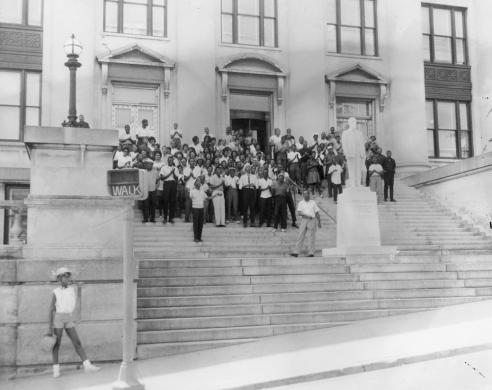Danville
The most violent episode of the civil rights movement in Virginia occurred in Danville during the summer of 1963—at about the same time that violence erupted in Birmingham, Alabama. In the early 1960s Danville was a tobacco and textile town of about 46,000 people, including some 11,000 Black residents.

A few years before, in 1960, Black there had organized the Danville Christian Progressive Association (DCPA), which was affiliated with the Southern Christian Leadership Conference (SCLC), led by Dr. Martin Luther King, Jr. The DCPA soon began to organize protests, including a sit-in at the Danville Public Library—an important site because the same structure, a mansion built in 1859, had briefly hosted the remnants of the Confederate government as its leaders fled Richmond at the end of the Civil War. Danville’s white community proudly clung to the moniker “the last capital of the Confederacy” in the 1960s; the city chose to close the library rather than allow Black visitors. A court order, issued in the fall of 1960, forced officials to reopen the library and integrate the historic site, but it did not prevent them from removing all of the tables and chairs, thereby presenting protestors with a somewhat symbolic victory. Nonetheless, the event further stoked tensions in the city.
On May 31, 1963, a group representing a broad cross-section of the Black community and organized by the DCPA marched to the municipal building. The protesters in Danville pressed for desegregated facilities, equal employment opportunities, representation in city government, and creation of a biracial commission to monitor racial progress. Led by two Danville ministers, Reverend Lawrence Campbell and Reverend Alexander I. Dunlap, this protest was largely ignored by the local press; no one was arrested.
But events soon escalated as demonstrations picked up steam. On June 10, police violently broke up a prayer vigil held for Black protestors arrested earlier in the day. Police used high-pressure hoses on the attendees at the vigil, and wielded batons on many of them after they were knocked to the ground. Deputized white city workers joined the police in beating the protestors, seriously injuring dozens of people.
Other white officials acted in a coordinated fashion, and used a variety of instruments, to bolster an atmosphere of intimidation. Judge Archibald M. Aiken issued an injunction to limit the protests; he cited an 1859 "John Brown" statute against "any person conspiring to incite the colored population to insurrection.” After many Black students were arrested in early June and taken to jail, they were allowed to call their parents—who, upon their arrival, were arrested for contributing to the delinquency of a minor. Officials sought high bail (with bonds for some individuals reaching $5,000.00), and attempted to change the venue of court cases to districts more than 100 miles away.
The Danville protesters' demands were never met by local authorities. Although demonstrations continued through the summer of 1963, national attention soon turned to the March on Washington and to the killing of four little girls in the bombing of Sixteenth Street Baptist Church in Birmingham. Black residents of Danville were forced to wait for action to be taken at the national level, namely the Civil Rights Act of 1964 and the Voting Rights Act of 1965, to see their complaints answered.
